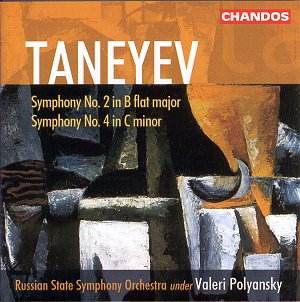Both Taneyev and Balakirev helped direct the development
of Tchaikovsky. While Balakirev has never been short of orchestral recordings
(nimbly helped along by the interest taken by Beecham and Karajan in
the First Symphony) Taneyev has struggled to grasp any public attention.
The first movement of the Second Symphony is
gravely liturgical and pregnant with tension then fiery with an energy
half Coriolan and half Dvořák's
Eighth Symphony. It reminded me of Fibich's Third Symphony. The stolid
andante of this three movement symphony is almost as long
as the first movement at 13.01. Its nature is reticent and hymnal lit
by woodwind silverpoints. The Allegro is big-boned and stompingly
uproarious mixing a tendency to colossal dance figures (like Beethoven's
Seventh Symphony) with Dvořák. The
trumpet assertion at 4.27 in the third movement glares in dark celebration.
The last few minutes sound rather Tchaikovskian.
The Fourth Symphony is in four movements. It
makes the most of the hall's cavernous and lively acoustic. This is
made to sound like a big piece about the great life themes and eternal
issues. The brass addresses are melodramatic, chasmal and inkily turbulent
suggestive of Tchaikovsky's Manfred and early Miaskovsky with
the odd dash of Brahms along the way. The contented adagio is
about the same length as the andante of the Second Symphony.
Its successor is a skipping wind-led scherzo in which the more
animated sections of Beethoven's Pastoral meet the scherzo
qualities of Glazunov's Fourth and Fifth Symphonies. The gutsy finale
is sturdy and ends in brassy grandeur, braying glory and Brahmsian majesty.
The Symphony is dedicated to Glazunov who also conducted its premiere.
This is the only Tanayev symphony to have been published.
I have been critical of Polyansky's approach in the
Glazunov symphonies. I had my concerns here but in fact he plays these
two works with zest and character; genuinely engaged by their invention.
Polyansky was a pupil of Oddisey Dimitriada (who recorded several of
Glazunov's more obscure orchestral pieces for Melodiya) and of Gennady
Rozhdestvensky.
The notes are by David Nice, one of the leading authorities
on Russian music. He does not explain why it is that the only Taneyev
symphonies we ever hear are these two. Whatever happened to the First
and Third?
This is not the first time that these two works have
been coupled. The Marco Polo CD was rather a damp squib and by all accounts
the interpretatively much better Melodiya Harmonia Mundi CD was rather
raw and unsubtle. [Jeffrey Davis writes in to say there
is also an identical coupling with the USSR Radio and TV Orchestra/Fedoseyev
(Symphony 2) and Novosibirsk PO/Arnold Katz (Symphony 4) on Russian
disc RDCD11008]
Stonkingly good performances of music that, rather
like the Glazunov symphonies, only succeeds when it is played all out.
Polyansky sloughs off his reputation for the languid and the meandering
to give these two symphonies the performances of a lifetime.
Rob Barnett


